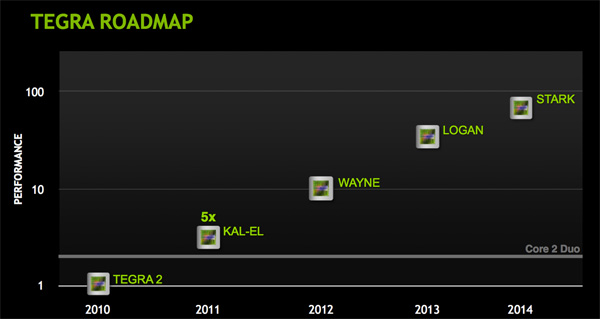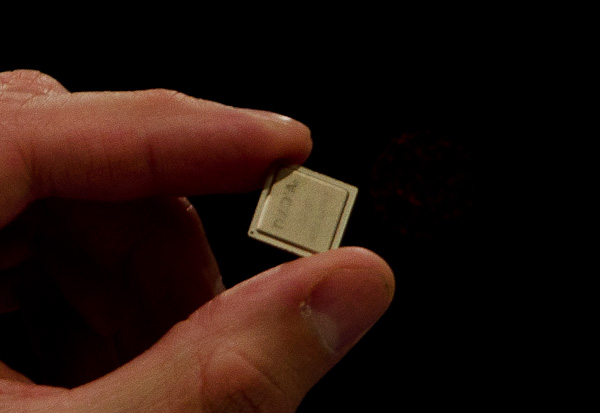NVIDIA's Kal-El Glowball Shows off Dynamic Lighting & Quad-Core Physics on a Tablet
by Anand Lal Shimpi on May 29, 2011 11:00 PM ESTI've warned both Qualcomm and TI that the danger they have to face in the SoC space going forward isn't just NVIDIA engineering, but NVIDIA marketing. Although too aggressive for my tastes at times, NVIDIA does know how to take a simple product release and turn it into an extremely polished technology launch. Even down to the materials NVIDIA shares with the press, to-date none of its competitors have built such pretty slides that make their way all over the web.
Obviously it's not just marketing with NVIDIA. After a rough start the Tegra 2 finally got real traction and has been the premier Android smartphone and tablet SoC since the beginning of the year. If you're buying an Android smartphone or tablet today, chances are the best option uses Tegra 2.
At MWC earlier this year NVIDIA announced its third applications processor, codenamed Kal-El. Kal-El will feature four ARM Cortex A9 cores with a shared 1MB L2 cache and MPE/NEON support (absent from Tegra 2). Kal-El will also fix the video decoder issue we've run into on Tegra 2 and should be able to play all high profile H.264 content with proper OS support. On top of all of that there's a faster GPU (12-core vs. 8-core plus higher throughput per core).

What does all of this have to do with NVIDIA's marketing? Today NVIDIA posted one of its famous tech demos running on a Kal-El reference platform to show off what's possible with the new SoC:
The video shows the output from a Honeycomb Kal-El development platform. In it you see techniques such as dynamic lighting and real-time physics. The latter uses all four of Kal-El's A9 cores, which you can see in action in the lower left of the video.
The Glowball demo is the perfect example of NVIDIA knowing how to execute on both the product and marketing sides when it comes to any major launch. Kal-El is still months away, but this is a great way to build excitement.
As always it's a pretty impressive tech demo but it's just that, a demo. As we've seen in the past, NVIDIA's tech demos are usually far more impressive than the actual titles we see released in the near term. After all, it's always easier to make a single scene look great vs. an entire game (not to mention that performance requirements go up as you add more dynamic characters in a given scene). But as a demo of what will be possible on a tablet by the end of the year, I can't complain.
NVIDIA said that Kal-El based devices are on track for release this holiday season. The original commitment was August 2011 but NVIDIA wouldn't be any more specific than to say that we may see some products launch before the holidays.

I suspect we may see more on Kal-El at Computex next week.












51 Comments
View All Comments
metafor - Monday, May 30, 2011 - link
And if you look at total volume sold last year. Snapdragon didn't exactly blow OMAP3 or Hummingbird out of the water either. It sold a ton, yes, but so did everyone.That's kinda the point. There's hype and there's reality.
Tegra 2 has the added disadvantage that the market it won a lot of design wins in did not explode in sales like the phone market did.
Nobody's counting nvidia out but there's a marked difference between hype and reality. And I'm not sure I like the suggestion that we travel down a path of companies trying to out-hype eachother through crafted demos, trash talk and underhanded artificial limitation of platforms that fragment the android market.
moozoo - Monday, May 30, 2011 - link
I think Apple owns the tablet market and they want to keep it that way.They are out to kill off all competitors before they even get started.
Whatever Nvidia throws at it, Apple will pre-emptively respond.
The A5 owned the Tegra 2. I'd expect the same will happen with the A6 vs Kal El.
dragonsqrrl - Monday, May 30, 2011 - link
The A5 also debuted many months after the first Tegra 2 devices came to market, so I'm not sure what you're talking about with Apple's "pre-emptive" response. Kal-El is also set to debut long before the first A6 device hits the market (most likely the ipad 3). Tablets should be available this holiday season, and the first smart phones should be out in Q1 2012.And I'm not sure how you can say "Apple owns the tablet market" based purely on the A series SOC's when Apple doesn't actually engineer a single major component of the A4/A5. The biggest thing that makes the A5 so much faster then any other SOC on the market today is Imagination Techs PowerVR SGX543.
jalexoid - Monday, May 30, 2011 - link
"The A5 also debuted many months after the first Tegra 2 devices came to market"A5 debuted a year after Tegra2 hit production.
"The biggest thing that makes the A5 so much faster then any other SOC on the market today is Imagination Techs PowerVR SGX543. "
And the inclusion of NEON module.
Lucian Armasu - Monday, May 30, 2011 - link
Perhaps, A6 will be a bit better than Tegra 3, but it will be out 6 months later. And then Tegra 4 will be out in another 6 months and it will be better than A6. And so on. Their chip roadmaps don't overlap. It only seems that way now because Tegra 2 was delayed for multiple reasons, but this is why we're going to see Tegra 3 "so early" now, because it will actually be on track this time, and the OS is ready for it.Fox5 - Monday, May 30, 2011 - link
Seems like phones and tablets are finally getting tech demos worthy of the Geforce DDR! Dynamic lighting? At best, we're looking at (low end) Gefore FX level here, although it's interesting nvidia went quad core rather than really pumping up the GPU. The GPU is weak compared to the competition, but Kal-El might just be the strongest ARM part by cpu this year.eddman - Monday, May 30, 2011 - link
"The GPU is weak compared to the competition"Kal-El isn't even out yet. How do you know if its GPU is weaker than SGX 543?!
"At best, we're looking at (low end) Geforce FX level here"
Performance wise, Tegra 2 seems to be at the level of a Geforce 6200 LE at 300 MHz.
If Kal-El has 2 MADs per SIMD and 8 pixel and 4 vertex shaders , it might perform as good as a Geforce 6600.
P.S. I'm comparing GPUs, not cards or phones, so I left out memory and bandwidth numbers, although they seem to be comparable.
http://en.wikipedia.org/wiki/Comparison_of_Nvidia_...
Alien959 - Monday, May 30, 2011 - link
And because the limited resolution of smartphones I think if the use 64bit memory controller with some low voltage ddr3 ram let say 533Mhz is enough for given application.Tablets with 200-300 DPI screens are another question but given their size advantage the can be more advanced memory configurations there.
SquattingDog - Monday, May 30, 2011 - link
Anyone else feel that the Tech Demo seems to have relatively low FPS - even when he says "back on four cores...smooth as butter"...Still, this is amazing for smartphone level equipment, good to see this tech going forwards so fast :)marc1000 - Monday, May 30, 2011 - link
I want to see this tech go fast enough that in a couple of years we will have tablets capable of runing VMWare software on them, emulating a x86 CPU in a way we could run, say, some serious server software on it. even if it was really slow, but it could replace a BOOK + NOTEBOOK for someone who has to study.example: reading a big PDF on the tablet, you get to an simulation. just touch some buttons, launch VMWare, launch Windows 2008 with SQL 2008, then open SSMS and check the items from the book. all in one screen, on your hand, anywhere. =D